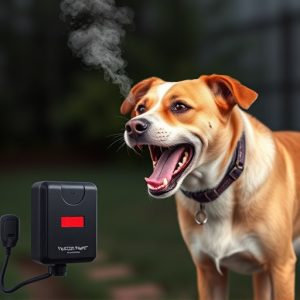Dog Repellent Devices: Safety, Effectiveness, and Future Noise Deterrents
Animal control sonic defense tools, or dog repellent devices (DRDs), have gained popularity for non-…….
Animal control sonic defense tools, or dog repellent devices (DRDs), have gained popularity for non-lethal protection against unwanted dog intrusions. These devices emit high-frequency ultrasonic sound waves to deter dogs without harm. Dog Repellent Device Compliance Testing is vital to ensure their safety and effectiveness by assessing factors like sound intensity, frequency, and potential side effects on animals. Strict testing guarantees these devices meet regulatory standards, maintain deterrence integrity, and offer reliable, user-friendly, and eco-conscious solutions for dog owners.
“Unleashing a new era in pet management, Animal Control Sonic Defense Tools offer innovative solutions for dealing with unwanted animal presence. This article delves into the intricacies of these devices, focusing on the Dog Repellent Device and its advanced functionality. We explore the science behind compliance testing to ensure safety and effectiveness, highlighting key standards. Furthermore, we look ahead to the future of noise-based pet deterrents, expecting a rise in their popularity due to their humane and eco-friendly nature. Understanding these tools is crucial for both pet owners and professionals alike.”
- Understanding Animal Control Sonic Defense Tools
- Dog Repellent Device: A Closer Look at Its Functionality
- Compliance Testing for Safety and Effectiveness
- Exploring the Future of Noise-Based Pet Deterrents
Understanding Animal Control Sonic Defense Tools
Animal control sonic defense tools, also known as dog repellent devices, have gained popularity as a non-lethal method to protect individuals and property from unwanted animal intrusions, particularly dogs. These devices emit high-frequency sound waves that are designed to be annoying or unpleasant to animals, encouraging them to leave the area without causing harm. Understanding how these tools work is crucial for their effective use and ensuring compliance with regulations.
Compliance testing plays a vital role in the development and market availability of dog repellent devices. This process involves rigorous evaluations to ensure the safety and efficacy of the product. Manufacturers must adhere to specific standards, such as those set by relevant authorities or industry bodies, to prove that their devices meet the required safety levels for both users and animals. The testing typically covers factors like sound intensity, frequency range, and potential side effects on different animal species. By undergoing these tests, manufacturers can guarantee that their animal control sonic defense tools are not only effective but also responsible, ensuring peace of mind for consumers.
Dog Repellent Device: A Closer Look at Its Functionality
Dog Repellent Devices, also known as ultrasonic noise makers or animal deterrents, have gained popularity as a non-lethal approach to keeping dogs away from specific areas. These innovative tools emit high-frequency sound waves designed to be unpleasant for canines but inaudible to humans. The primary principle behind their functionality is based on sensory disruption, where the device’s ultrasonic emissions create an uncomfortable experience for the target dog, encouraging them to avoid the treated area.
Compliance testing plays a crucial role in ensuring these devices meet safety standards and regulatory requirements. Dog Repellent Devices must undergo rigorous assessments to guarantee they operate within safe sound pressure levels, typically below 130 decibels, to avoid potential hearing damage. Additionally, these tests evaluate the device’s effectiveness against various canine behaviors, ensuring it can withstand different scenarios and maintain its deterrence capabilities over time.
Compliance Testing for Safety and Effectiveness
In the realm of animal control, ensuring the safety and effectiveness of a dog repellent device is paramount. Compliance testing plays a crucial role in verifying that such tools meet established standards and regulations. This rigorous process involves meticulous evaluations to safeguard both users and animals, confirming the product’s ability to deter canine intrusions without causing harm.
The Dog Repellent Device Compliance Testing procedure delves into various aspects, including performance, safety protocols, and environmental impact. By subjecting these devices to simulated scenarios, experts assess their reliability in repelling dogs while adhering to strict safety guidelines. This comprehensive approach ensures that the tools are not only effective but also user-friendly and environmentally conscious, making them ideal solutions for managing canine behavior in diverse settings.
Exploring the Future of Noise-Based Pet Deterrents
The future of noise-based pet deterrents, such as animal control sonic defense tools, looks promising with advancements in technology and a growing demand for humane solutions. These devices use sound waves or ultrasonic frequencies to create an unpleasant experience for pets like dogs, encouraging them to stay away from certain areas. Ongoing research and development focus on improving their effectiveness while minimizing potential harm to animals and the environment.
Compliance testing plays a pivotal role in ensuring these dog repellent devices meet safety standards and regulatory requirements. Rigorous testing protocols evaluate sound pressure levels, frequency ranges, and overall performance under various conditions. By adhering to strict guidelines, manufacturers can guarantee that their products are not only effective but also safe for both pets and humans, paving the way for wider acceptance and integration into everyday life.
Animal control sonic defense tools, particularly dog repellent devices, offer a non-lethal and humane approach to keeping pets away from sensitive areas. Through rigorous compliance testing for safety and effectiveness, these innovative solutions have proven their worth in the market. As research progresses, the future of noise-based pet deterrents looks promising, with potential advancements in technology offering even more effective and environmentally friendly options. By understanding these tools and their functionality, we can effectively navigate a world where both pets and people coexist harmoniously in various environments.


